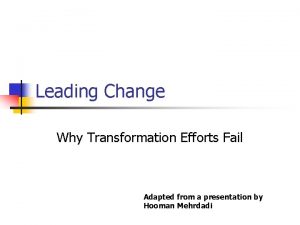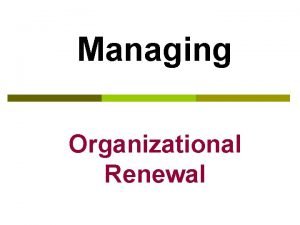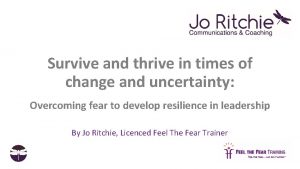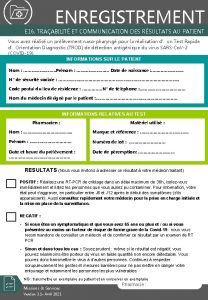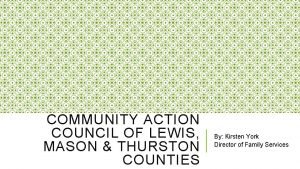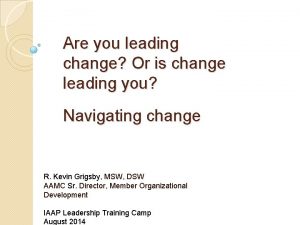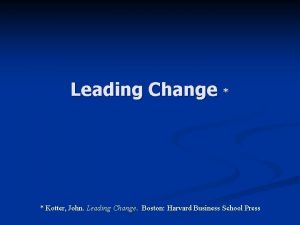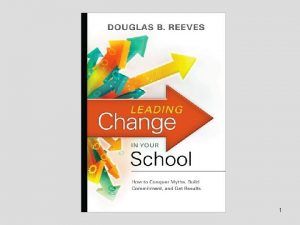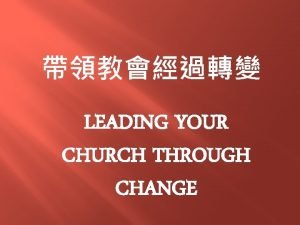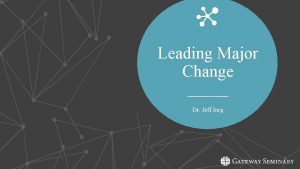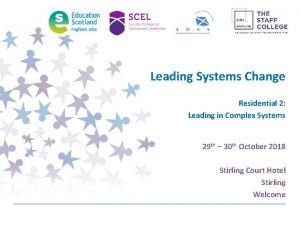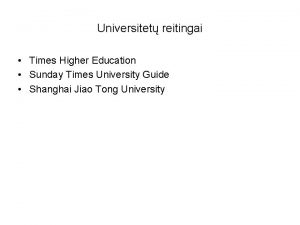LEADING EDUCATION CHANGE IN TIMES OF COVID POLICY

















- Slides: 17

LEADING EDUCATION CHANGE IN TIMES OF COVID: POLICY LESSONS FOR THE FUTURE Beatriz Pont From Crisis to the future ARC THOUGHTMEET Jan 17, 2021

School readiness for alternatives in education delivery, 2018 Selected indicators from 2018 Source: Fig 1. 1. Education Policy Outlook 2020

Country priorities following COVID first wave, Q 2 2020 To a great extent To some extent Ensure the continuity of the academic learning of students Ensure continuity/integrity of the assessment of student learning Provide professional support, advice to teachers Ensure social development of students Ensure support for parents and caregivers to support student learning Support education of disadvantaged students Ensure well-being of teachers Revise graduation/grade transition policy to allow student progress Ensure provision of other social services to students Ensure medical attention to teachers affected by Covid-19 Support students at risk of violence at home Ensure medical attention of students affected by Covid-19 0 20 40 60 Source: Reimers F. , Schleicher A. (2020), https: //globaled. gse. harvard. edu/files/geii/files/framework_guide_v 2. pdf 80 100

Education responses to COVID, first wave Q 2 2020 How challenging was it to implement the following? Source: Reimers F. , Schleicher A. (2020), https: //globaled. gse. harvard. edu/files/geii/files/framework_guide_v 2. pdf

Processes to shape education responses to COVID, first wave Q 2 2020 Averages across 36 countries, May 2020 Completely agree Agree Everybody did all they could to help It was designed in a collaborative manner including teachers It was well planned It was well executed Communications were well managed There was strong collaboration between public and private sectors It was designed in a top down fashion by the government It was designed in a collaborative manner including parents It was designed in a collaborative manner including the community There were conflicts with teachers There were conflicts with parents There were conflicts between schools and the government It was fairly chaotic % 0 20 40 60 Source: Reimers F. , Schleicher A. (2020), https: //globaled. gse. harvard. edu/files/geii/files/framework_guide_v 2. pdf 80 100

Policies for education systems in time of COVuncertainty • Student learning and wellbeing – Intermittent school closures: quick shifts and reorganisation to maintain learning and school communities – Complementary remote approaches: technology, TV, radio and home schooling • Education professionals and schools adaptability – Flexibility for constant adaptations – Skills for new ways of teaching and interaction with students • Reviewed accountability systems – Shifted student assessments, student progression assessments to teachers’ assessments – school and system evaluations stopped… • Inequalities in access – Efforts to mitigate increased risks for disadvantaged: lunches, spaces, additional support (IT or other) 6

Education delivery, primary and secondary, Q 4 2020 Source: Fig 1. 2. Education Policy Outlook 2020

Selected policy responses to COVID in 2020 OECD (2020), Lessons for Education from COVID-19: A Policy Maker’s Handbook for More Resilient Systems

• • • Inequalities in access Education professionals adaptability Adapted accountability systems • Prioritise safe schooling • Health and education guidelines • Data/resources • Technology infrastructure Alternative provision • Professional development/ networks • Assessment alternatives • Prioritize school community • Apply guidelines to school • Deliver and transition online/real Homes Student learning and wellbeing Schools • Public policy Leading education systems in time of COVuncertainty • Prioritise learning /wellbeing • Follow guidelines • Adapt to schooling • Reach out • Understand needs/Reach out • Capacity/ practitioners • Understand teachers challenges • Gauge student learning • New types of assessments 9

Leading education responses to COVID-19: takes time to adapt change processes Dimensions Short term Identify key context factors Fixed resources, IT and capacity Stakeholders as drivers Initially reactive; in small number; roles very organic Policy to respond to school needs No vision; quick use of already available IT Schools to deliver Make strategy actionable Quick in school closures Communication Mid term Long term IT networks Resources needed Complementary policies Define the resources, Identify health context, Assessments? Test engagement and communication; define roles and responsibilities Consolidate consultation process; clear roles; leadership Shaping the vision Clear vision: equity, quality and well being; Hybrid learning models; school as a community Schools empowered, setting of guidelines, capacity development Changes on-going, start monitoring Develop knowledge to understand progress and avoid potential pitfalls. 10

Rather than adapt. …. Focus on leading education change in times of uncertainty Dimensions Short term Plan for key contextual factors Fixed resources, IT and capacity Define stakeholder approaches Initially reactive; in small number; roles very organic Define policy priorities No vision; quick use of already available IT Schools to deliver Make strategy flexible Quick in school closures Communication Mid term Long term IT networks Resources needed Complementary policies Define the resources, Identify health context, Assessments? Test engagement and communication; define roles and responsibilities Consolidate consultation process; clear roles; leadership in schools Shaping the vision Clear vision: equity, quality and well being; Hybrid learning models; school as a community Schools empowered, setting of guidelines, capacity development Changes on-going, start monitoring Develop knowledge to understand progress and avoid potential pitfalls. 11

Unexpected and unplanned results from education responses to COVID first wave, Q 2 2020 Were there unexpected positive educational results from the changes? Source: Reimers F. , Schleicher A. (2020), https: //globaled. gse. harvard. edu/files/geii/files/framework_guide_v 2. pdf

Instead… a change perspective can help countries develop their policy responses more systematically for the future Adapting to external change or leading change? 5 4, 5 4 3, 5 3 2, 5 2 1, 5 1 0, 5 0 A systemic view on leading change for times of uncertainty. Lessons from the crisis show that effective change processes can be key to shape education policy actions in times of uncertainty. In times of crisis: • Resources, time and capacity are binding • Evidence is limited • Policy decisions need to be fast, reliable and adapted Adopting an education change framework can: • Save time, efforts, and result in better outcomes. • Help define the processes for effective change so that policy can reach its objectives • Support decision making in times of uncertainty, which requires a combination of short term responses within a long term policy vision. 13

Rather than adapt. …. Focus on leading education change in times of uncertainty Example: student assessments 14

0 Tables I. 2. 1 and I. 2. 4 Japan French (Belgium) Shanghai (China) Belgium Korea Austria Czech Republic France Slovenia Flemish (Belgium) 2018 South Africa England (UK) Brazil Singapore Viet Nam 80 Bulgaria Estonia Croatia Italy Slovak Republic Malta Hungary Latvia Saudi Arabia Finland Netherlands Spain Israel OECD average-31 Georgia Iceland Romania Portugal United States Lithuania Sweden Chile CABA (Argentina) Alberta (Canada) Kazakhstan Turkey Mexico Russia 90 Colombia 100 United Arab Emirates Australia New Zealand Denmark Rather than adapt. …. Focus on leading education change in times of uncertainty Example: technology use in schools Percentage of teachers who “frequently” or “always” let students use ICT for projects or class work 2013 70 60 50 40 30 20 10 15

Measure progress? When? Resources? Who is responsible? How will this be done? Leading education change in times of uncertainty Design educational policy to respond to student needs • Develop a clear vision of priorities and key educational principles: equity, quality, well-being and safety. • Choose mode of education delivery based on resources and stakeholders’ feedback • Empower schools in delivery of learning and provide professional development for teachers and leaders. Consider stakeholders as the main drivers of change • Build effective co-construction process for education responses to be sound, well supported and updated. • Define and focus responsibilities of the different stakeholders on supporting education delivery. • Use existing tools to enhance communication between stakeholders and across the system Identify and build on potential contextual factors • Assess resources and capacity to lead at different levels of the system • Broaden co-operation with potential partners • Weave health, student welfare and assessment policies in the education response Shape a clear and coherent implementation strategy • Bring together different dimensions: timeframes, responsibilities, tools, and available resources. • Develop knowledge to monitor implementation, understand progress and adapt strategy. • Establish a communication strategy that can reach different audiences. 16

Thank you! For further information: Beatriz Pont Policy Advice and Implementation Division OECD Directorate for Education @beatrizpont www. oecd. org/education/implementing-policies • Gouëdard, P. , B. Pont and R. Viennet (2020), “Education responses to COVID-19: shaping an implementation strategy”, OECD Education Working Papers, No. 224, https: //doi. org/10. 1787/8 e 95 f 977 -en. • OECD (2020), "Education responses to COVID-19: an implementation strategy toolkit", OECD Education Policy Perspectives, No. 5, OECD Publishing, Paris, https: //doi. org/10. 1787/81209 b 82 -en. 17
 Bobbin leading principle
Bobbin leading principle 15 times 15 times 20
15 times 15 times 20 Leading change: why transformation efforts fail
Leading change: why transformation efforts fail Leading change and organizational renewal
Leading change and organizational renewal Leading change and organizational renewal
Leading change and organizational renewal Nitcar
Nitcar Leading through change presentation
Leading through change presentation Leading international vaccinology education
Leading international vaccinology education Survive and thrive in times of change
Survive and thrive in times of change Sandra rak
Sandra rak Orticaria a frigore
Orticaria a frigore E16 tracabilite et communication des resultats au patient
E16 tracabilite et communication des resultats au patient Covid
Covid Thurston county covid
Thurston county covid Grieve everything we covid
Grieve everything we covid C.d.c. covid isolation health workers
C.d.c. covid isolation health workers How we covid
How we covid Covid isolation health workers
Covid isolation health workers


